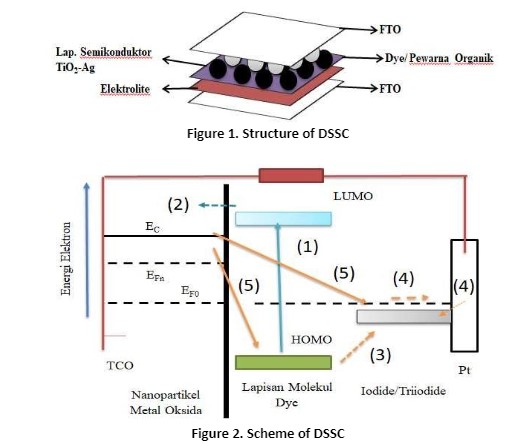Climate change is a factual problem in our lives. As time passes, fossil fuels emit harmful chemicals into our atmosphere. Renewable energy is needed as the cleanest alternative source of energy available. Dye-Sensitized Solar Cell (DSSC) is a photovoltaic device that has the ability to convert solar energy into electrical energy. DSSC is an organic-based solar cell that, in the process, utilizes organic dyes to absorb photon energy. This type of solar cell has been widely developed because it has several capabilities, such as easy-to-obtain raw materials, environmentally friendly, simple and cheap fabrication, and can be produced on a large scale.
Research developed by Dr. Herlin Pujiarti, M.Si and teams aims to obtain a DSSC prototype with a TiO2 nanoparticle electrode doped with Ag metal using the N719 co-sensitizer to produce a DSSC that has high efficiency due to the semiconductor structure. This is also in line with the goals mentioned in Sustainable Development Goals (SDGs), which are to produce affordable and clean energy (Goals 7. Affordable and Clean Energy) to promote a sustainable environment (Goals. Climate Action). Ag-doped TiO2 nanoparticle electrodes were synthesized by grinding them using a mortar and then dripping them with a therpinoel solution with concentration control using Ag metal, followed by the screen-printing method, then XRD, SEM-EDX, and UV-VIS characterization was carried out. After forming the DSSC prototype with Ag-doped ZnO nanorod electrodes and N719 dye, tests were carried out using the Solar Simulator (I-V) and impedance characterization (EIS). The research was proposed in an activity plan for ten months. Activities include fabricating Ag-doped TiO2 nanoparticles with varying concentrations of Ag, grinding them using a mortar, dripping them with a therpinoel solution followed by the screen-printing method and N719 dye, then creating a DSSC prototype. The characterization carried out includes XRD, SEM-EDX, UV-VIS, Solar Simulator, and EIS. The structure of DSSC is shown in Figure 1, and its scheme is shown in Figure 2.
Figure 1. Structure of DSSC
Figure 2. Scheme of DSSC
The implementation of this activity can be targeted at one publication in an international journal (material research express) or two proceedings indexed by Scopus. The output of this research is in the form of 1 Scopus international journal (>=Q2) or 2 Scopus-indexed proceedings journals, IPR, models/prototypes, and posters. To achieve the implementation of this research, we have collaborated with the University of Malaya Malaysia. To guarantee the implementation and achievement of research, the research team has research experience in the field of materials for the synthesis of 1D nanomaterials, photo supercapacitors, polymers, polycrystals, nanocrystals, and DSSC solar cells, patent registration, publication of articles in reputable international journals and book chapters and books. has an ISBN. The research was conducted in a year, from January 2023.
![]()

